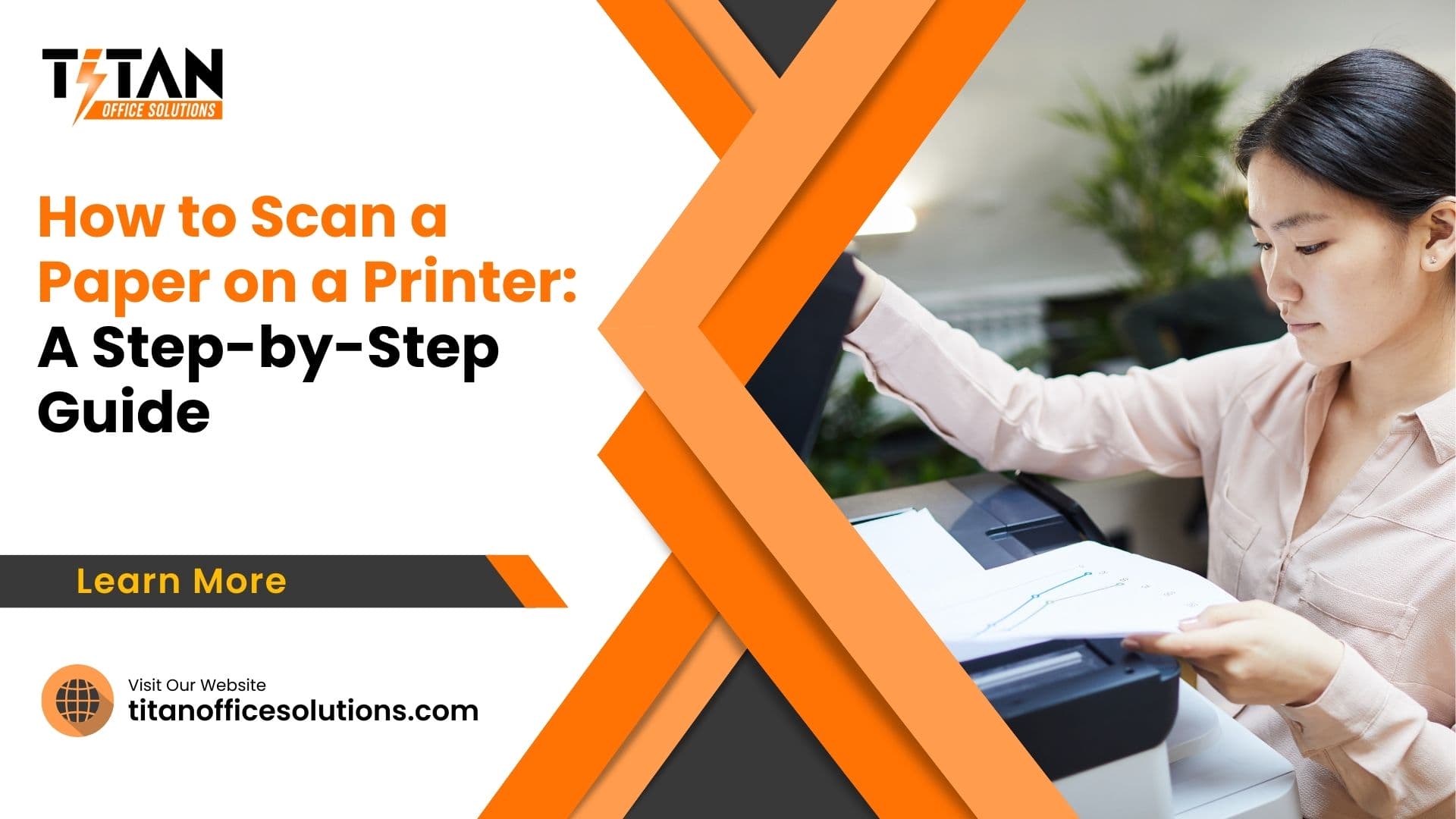How to Scan a Paper on a Printer?
Scanning documents offers a wealth of benefits. It allows you to transform physical papers into digital files, freeing up valuable physical space and making them readily accessible on your computer or mobile devices.
There are several ways to scan a document using a printer. Most modern multifunction printers (MFPs) combine printing, copying, and scanning functionalities in a single device. These MFPs typically feature a built-in flatbed scanner where you place your document face down for scanning. For documents with multiple pages, some MFPs include an automatic document feeder (ADF) that automatically feeds each page through the scanner, streamlining the process.
Scanning a document is a straightforward process that can be accomplished in just a few steps. We’ll guide you through everything you need to know, from checking your printer’s compatibility to saving your scanned documents in a usable format.

Before You Scan
Checking Printer Compatibility
Before diving into the scanning process, it’s crucial to confirm if your printer even has this capability. Most MFPs will clearly indicate “scan” or “copy/scan” on the control panel or product specifications. If you’re unsure, consult your printer’s user manual or manufacturer’s website for confirmation.
Preparing Your Document

The beauty of scanner technology is its versatility. You can scan a wide range of documents, including single sheets of paper, photographs, receipts, and even business cards. For best results, ensure your documents are free of creases, tears, or any sticky substances. If your document is curled, gently flatten it by placing it under a heavy book for a while.
Gathering Necessary Supplies
The supplies you’ll need depend on your chosen scanning method. If you’re opting to scan directly to your computer, you won’t require any additional hardware. However, for scanning to a USB drive (thumb drive), ensure you have a compatible drive with enough storage space to accommodate your scanned document. For some printer models, you might need the printer’s specific software installed on your computer to facilitate the scanning process.
Scanning Your Document
Now that you’ve prepped your documents and confirmed your printer’s capabilities, let’s delve into the actual scanning process. There are several ways to achieve this, depending on your preference and printer model.
Scanning to a Computer
Connecting Your Printer
The first step involves establishing a connection between your printer and computer. Most modern printers offer both wired (USB cable) and wireless (Wi-Fi) connectivity options. Consult your printer’s manual for specific instructions, but generally, connecting via USB is a straightforward process of plugging the cable into both devices. For wireless connections, you’ll likely need to follow on-screen prompts on your printer to establish a connection to your Wi-Fi network.
Using Your Computer’s Scanning Software
Once connected, you can leverage your computer’s built-in scanning software. On Windows 10, you can access this software by searching for “Windows Fax and Scan” in the Start menu. For Mac users, the scanning functionality might be integrated with applications like Image Capture or your printer manufacturer’s software. These programs typically offer a user-friendly interface where you can initiate a scan, place the document on the scanner bed (flatbed scanner) or in the automatic document feeder (ADF) (if available), and adjust basic scan settings like resolution (DPI) and color mode (color, grayscale, black & white).
After selecting your desired settings, simply click the “Scan” button and the program will capture a digital image of your document. You’ll then have the option to preview the scanned image, make adjustments if necessary, and save it to a designated folder on your computer in your preferred file type (e.g., PDF, JPG).
Scanning with a Third-Party App
While using your computer’s built-in software is convenient, some users might prefer the additional features offered by third-party scanning apps. These apps, like Adobe Scan or Evernote Scannable, can often provide a more streamlined scanning experience. They might offer functionalities like automatic document detection, multi-page scanning capabilities, and advanced image editing tools. These apps typically require a download and installation on your computer and often come with free and premium versions offering varying features.
Scanning to a USB Drive
Locating the USB Port
If you don’t have your computer readily available or prefer to save your scans directly to a portable storage device, you can utilize the scan-to-USB function (if your printer offers it). The USB port on your printer is usually located on the front or side panel. It’s a rectangular slot where you’ll insert your USB drive.
Initiating a Scan-to-USB
The process for initiating a scan-to-USB function varies depending on your printer model. However, it generally involves accessing the scan menu on the printer’s control panel and selecting the “Scan to USB” option. You might then need to choose the specific USB drive (if multiple are connected) and define the scan settings like document type (photo, text) and resolution. Once everything is set, simply place your document on the scanner bed or in the ADF and press the “Start” button to initiate the scan. The scanned document will be saved directly to your USB drive.
Transferring the Scanned Document
After completing the scan-to-USB process, you can transfer the scanned document to your computer by inserting the USB drive into a USB port on your computer. Your computer will typically recognize the drive and allow you to access the scanned files. You can then copy or move the scanned document to a desired folder on your computer for safekeeping and organization.
Scanning to Email
Checking Printer Compatibility
Not all printers offer the convenient scan-to-email functionality. This feature allows you to scan a document and directly send it as an email attachment. Before attempting this method, consult your printer’s manual or manufacturer’s website to confirm compatibility.
Setting Up Scan-to-Email
If your printer supports scan-to-email, you’ll likely need to set it up initially. This might involve configuring your printer’s network settings and specifying your email address on the printer’s control panel. Some printer models might require additional software installation to facilitate scan-to-email functionality.
Sending the Scanned Document
Once set up, scanning to email is a breeze. Simply place your document on the scanner bed or in the ADF, navigate to the “Scan to Email” option on the printer control panel, and enter the recipient’s email address. You might even be able to add a subject line and brief message before hitting “Start” to initiate the scan and send the document electronically.
Optimizing Your Scans

Now that you’ve mastered the art of initiating scans, let’s delve into some techniques to optimize your scanned documents. This ensures they not only look great but are also manageable in terms of file size.
Choosing the Right Scan Resolution
One of the most crucial settings to consider is scan resolution, often measured in dots per inch (DPI). Essentially, DPI refers to the number of tiny dots used to represent an inch in your scanned image. A higher DPI translates to a sharper, higher-quality scan but also results in a larger file size.
For text documents containing mostly black and white text, a resolution of 300 DPI is generally sufficient. However, for photos or images with intricate details, you might opt for a higher resolution (600 DPI or above) to preserve image quality.
Adjusting Scan Settings
In addition to DPI, many scanners offer other adjustable settings you can fine-tune depending on your document and desired outcome. These might include color mode (color, grayscale, or black & white) – suitable for text-heavy documents. You can also adjust the document size (letter, A4, etc.) and orientation (portrait or landscape) to ensure your scanned image matches the original document’s format. Most scanning software allows you to preview these settings before finalizing the scan, offering greater control over the final product.
Previewing Your Scan
Taking a moment to preview your scan before saving it is a valuable step. The preview function allows you to assess the quality of the scanned image, ensuring it’s clear, properly aligned, and captures all the necessary details. If you notice any blemishes, cropping issues, or incorrect settings, you can easily adjust them before finalizing the scan. This saves you time and reduces the need to rescan the document later.
Saving and Sharing Your Scans
Selecting a File Format
Once you’re satisfied with your scanned document, it’s time to save it in a suitable file format. Common options include PDF (ideal for preserving document formatting and sharing), JPG (commonly used for photos due to its compressed size), and BMP (lossless format for high-quality images but resulting in larger file sizes). Choose the format that best suits your needs – archiving important documents might call for PDFs, while sharing photos online might favor JPGs.
Saving Your Scanned Document
Most scanning software allows you to designate a specific folder on your computer to save your scanned documents. This helps you organize your digital files efficiently. For instance, you could create dedicated folders for different categories of scanned documents (receipts, contracts, personal documents) for easy retrieval later.
Sharing Your Scans
There are numerous ways to share your scanned documents electronically. You can attach them to emails, upload them to cloud storage services like Dropbox or Google Drive, or even share them directly through social media platforms (depending on the document type and privacy considerations).
Troubleshooting Common Scanning Issues
Even with the best intentions, occasional glitches can occur during the scanning process. Here are some common scanning problems and tips to troubleshoot them:
- Document Not Feeding: This could be due to a wrinkled document, dirt or debris in the feeder tray, or an incorrectly sized document. Solution: Gently flatten any curled edges, ensure the feeder tray is clean and free of obstructions, and verify your document size matches the scanner’s specifications. Refer to your printer’s manual for detailed cleaning instructions.
- Blurry Scans: Blurry scans can be caused by a dirty scanner glass, incorrect focus settings, or improper document placement. Solution: Clean the scanner glass with a lint-free cloth and a mild cleaning solution (consult your printer manual for recommended cleaning products). Double-check your scan settings and ensure the document is placed flat and aligned on the scanner bed.
- Scanned Text Appears Incorrect: This might indicate a problem with Optical Character Recognition (OCR), a technology that converts scanned text into editable text. Solution: Ensure your scanning software’s OCR functionality is enabled and up-to-date. Additionally, consider using a higher scan resolution (especially for text-heavy documents) to improve OCR accuracy.
- Error Messages: Sometimes, the printer might display error messages during scanning. These messages typically provide clues about the issue. Solution: Consult your printer’s user manual for specific troubleshooting steps corresponding to the displayed error code. The manufacturer’s website might also offer a searchable database of frequently asked questions (FAQs) that can address common scanning problems.
If these initial troubleshooting steps don’t resolve the issue, contacting your printer’s manufacturer’s customer support for further assistance might be necessary.
Conclusion
Utilizing the scan option on your HP printer or any multifunction printer is a breeze! This guide has equipped you with the knowledge to learn how to scan a variety of documents, from single sheets to photos.
By following these steps and considering the optimization tips, you can effortlessly transform your physical paperwork into convenient digital files.
So, next time you need to scan an important document, don’t hesitate to leverage this powerful functionality offered by your printer!
Titan Office Solutions
Phone: (704) 741-0821
Email: info@titanofficesolutions.com
Hours of Operations: Monday through Friday from 8:30 AM to 6 PM EST.
Website: titanofficesolutions.com

